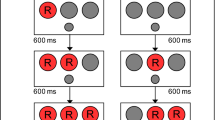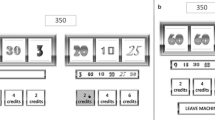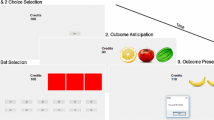Abstract
Traditionally, near-miss events in games of skill provide feedback to an individual regarding his or her performance. However, in games of chance, like slot machine gambling, the use fails to carry over. A near miss in slot machine gambling may still be endorsed when most of the symbols falling on a payline match, though technically this arrangement provides no real measure of skill or progress. To date, attempts to study the near miss in slot machine gambling have used resistance to extinction and preference assessment preparations, both of which unsuccessfully capture any putative reinforcement properties. The current investigation introduces a new methodology to assess putative conditioned reinforcement properties of stimuli correlated with the near miss in simulated slot machine gambling by incorporating the observing response with concurrently available schedules, termed simultaneous observing. Successful tests of the methodology regarding schedule-correlated stimuli in relation to win rates demonstrate its potential use, and failure to identify a near-miss event as producing reinforcing effects for schedule-correlated stimuli adds credibility to its ability to discriminate between functions.




Similar content being viewed by others
Notes
Modern slot machines may have over 100 paylines, though the traditional three matching symbols may still be present in the form of scatter symbol wins to initiate bonus games.
Full scripts can be obtained by contacting the primary author.
In the state in which the study was conducted, it is illegal to gamble with one’s own or someone else’s money, or for a cash prize, in an establishment without a gaming license. The procedure used disconnects the gambling outcome from the prize awarded.
References
Case, D. A., & Fantino, E. (1981). The delay-reduction hypotheses of conditioned reinforcement and punishment: observing behavior. Journal of the Experimental Analysis of Behavior, 35, 93–108.
Clark, L., Lawrence, A. J., Astley-Jones, F., & Gray, N. (2009). Gambling near-misses enhance motivation to gamble and recruit win-related brain circuitry. Neuron, 61, 481–490.
Clark, L., Crooks, B., Clarke, R., Aitken, M. R. F., & Dunn, B. D. (2012). Physiological responses to near-miss outcomes and personal control during simulated gambling. Journal of Gambling Studies, 28, 123–137.
Cooper, J. O., Heron, T. E., & Heward, W. L. (2007). Applied behavior analysis (2nd ed.). Upper Saddle River: Pearson.
Côté, D., Caron, A., Aubert, J., Desrochers, V., & Ladouceur, R. (2003). Near wins prolong gambling on a video lottery terminal. Journal of Gambling Studies, 19, 433–438.
Daugherty, D., & MacLin, O. H. (2007). Perceptions of luck: near win and near loss experiences. Analysis of Gambling Behavior, 1, 123–132.
DeLeon, I. G., Bullock, C. E., & Catania, A. C. (2013). Arranging reinforcement contingencies in applied stings: Fundamentals and implications of recent basic and applied research. In G. J. Madden et al. (Eds.), APA handbook of behavior Analysis: Vol. 2. Translating principles into practice. Washington, DC: American Psychological Association.
Dillen, J., & Dixon, M. R. (2008). The impact of jackpot and near-miss magnitude on rate and subjective probability of slot machine gamblers. Analysis of Gambling Behavior, 2, 121–134.
Dixon, M. R. (2010). The roulette near-miss effect. Analysis of Gambling Behavior, 4, 54–60.
Dixon, M. R., & Schreiber, J. E. (2004). Near-miss effects on response latencies and win estimations of slot machine players. The Psychological Record, 54, 335–348.
Dixon, M. R., MacLin, O. H., & Daugherty, D. (2006). An evaluation of response allocations to concurrently available slot machine simulations. Behavior Research Methods, 38, 232–236.
Dixon, M. R., Nastally, B. L., Hahs, A. D., Homer-King, M., & Jackson, J. W. (2009a). Blackjack players demonstrate the near miss effect. Analysis of Gambling Behavior, 3, 56–61.
Dixon, M. R., Nastally, B. L., Jackson, J. E., & Habib, R. (2009b). Altering the near-miss effect in slot machine gamblers. Journal of Applied Behavior Analysis, 42, 913–918.
Fantino, E. (1969). Choice and rate of reinforcement. Journal of the Experimental Analysis of Behavior, 12, 723–730.
Fantino, E. (2008). Choice, conditioned reinforcement, and the Prius Effect. The Behavior Analyst, 31, 95–111.
Fantino, E., & Moore, J. (1980). Uncertainty reduction, conditioned reinforcement, and observing. Journal of the Experimental Analysis of Behavior, 33, 3–13.
Fantino, E., & Romanowich, P. (2007). The effect of conditioned reinforcement rate on choice: a review. Journal of the Experimental Analysis of Behavior, 87, 409–421.
Fantino, E., & Silberberg, A. (2010). Revisiting the role of bad news in maintaining human observing behavior. Journal of the Experimental Analysis of Behavior, 93, 157–170.
Fantino, E., Preston, R. A., & Dunn, R. (1993). Delay reduction: current status. Journal of the Experimental Analysis of Behavior, 60, 159–169.
Ghezzi, P. M., Wilson, G. R., & Porter, J. C. K. (2006). The near-miss effect in simulated slot machine play. In P. M. Ghezzi, C. A. Lyons, M. R. Dixon, & G. R. Wilson (Eds.), Gambling: Behavior theory, research, and application (pp. 155–170). Reno: Context Press.
Gravetter, F. J., & Wallnau, L. B. (2008). Statistics for the behavioral sciences. Belmont: Wadsworth.
Griffiths, M. (1994). The role of cognitive bias and skill in fruit machine gambling. British Journal of Psychology, 85, 351–369.
Győző, K., & Körmendi, A. (2012). Can we perceive near miss? An empirical study. Journal of Gambling Studies, 28, 105–111.
Habib, R., & Dixon, M. R. (2010). Neurobehavioral evidence for the “near-miss” effect in pathological gamblers. Journal of the Experimental Analysis of Behavior, 93, 313–328.
Harrigan, K. A. (2007). Slot machine structural characteristics: distorted player views of payback percentages. Journal of Gambling Issues, 20, 215–234.
Harrigan, K. A. (2008). Slot machine structural characteristics: creating near misses using high award symbol ratios. International Journal of Mental Health, 6, 353–368.
Harrigan, K. A. (2009). Slot machines: pursuing responsible gaming practices for virtual reels and near misses. International Journal of Mental Health Addiction, 7, 68–83.
Haw, J. (2008). The relationship between reinforcement and gaming machine choice. Journal of Gambling Studies, 24, 55–61.
Hendry, D. P. (1969). Introduction. In D. P. Hendry (Ed.), Conditioned reinforcement. Homewood: The Dorsey Press.
Jensen, M. (2010). The big book of slots and video poker (2nd ed.). Las Vegas: Cardoza Publishing.
Kassinove, J. I., & Schare, M. L. (2001). Effects of the “near miss” and the “big win” on persistence at slot machine gambling. Psychology of Addictive Behaviors, 15, 155–158.
Lesieur, H. R., & Blume, S. B. (1987). The South Oaks Gambling Screen (SOGS): a new instrument for the identification of pathological gamblers. American Journal of Psychiatry, 144, 1184–1188.
MacLin, O. H., Dixon, M. R., Daugherty, D., & Small, S. L. (2007). Using a computer simulation of three slot machines to investigate a gambler’s preference among varying densities of near-miss alternatives. Behavior Research Methods, 39, 237–241.
Madden, G. J., & Perone, M. (1999). Human sensitivity to concurrent schedules of reinforcement: effects of observing schedule-correlated stimuli. Journal of the Experimental Analysis of Behavior, 71, 303–318.
Mead, D. R. (1983). Handbook of slot machine reel strips. Las Vegas: Mead Publishing Company.
Nastally, B. L., & Dixon, M. R. (2012). The effect of a brief acceptance and commitment therapy (ACT) intervention on the near miss effect in problem gamblers. The Psychological Record, 62, 677–690.
Nastally, B. L., Dixon, M. R., & Jackson, J. W. (2009). The effect of stopping devices and win rate on preference in slot machine players. Analysis of Gambling Behavior, 3, 27–30.
Near miss. (2012). In Oxford English Dictionary. Retrieved from http://www.oed.com/view/Entry/125544?redirectedFrom=near+miss#eid34963145
Peterson, J. M., & Weatherly, J. N. (2011). Comparing three strategies of motivating gambling behavior in the laboratory environment. Analysis of Gambling Behavior, 5, 28–34.
Piazza, C. C., Fisher, W. W., Hagopian, L. P., Bowman, L. G., & Toole, L. (1996). Using a choice assessment to predict reinforcer effectiveness. Journal of Applied Behavior Analysis, 29, 1–9.
Reid, R. L. (1986). The psychology of the near miss. Journal of Gambling Behavior, 2, 32–39.
Shahan, T. A. (2002). The observing-response procedure: a novel method to study drug-associated conditioned reinforcement. Experimental and Clinical Psychopharmacology, 10, 3–9.
Shahan, T. A., & Lattal, K. A. (1998). On the functions of the changeover delay. Journal of the Experimental Analysis of Behavior, 69, 141–160.
Shahan, T. A., Podlesnik, C. A., & Jimenez-Gomez, C. (2006). Matching and conditioned reinforcement rate. Journal of the Experimental Analysis of Behavior, 85, 167–180.
Shull, R. L., & Lawrence, P. S. (1998). Reinforcement: Schedule performance. In K. A. Lattal & M. Perone (Eds.), Handbook of research methods in human operant behavior (pp. 95–129). New York: Plenum Press.
Silberberg, A., & Fantino, E. (2010). Observing responses: maintained by good news only? Behavioural Processes, 85, 80–82.
Skinner, B. F. (1948). ‘Superstition’ in the pigeon. Journal of Experimental Psychology, 38, 168–172.
Skinner, B. F. (1953). Science and human behavior. New York: Macmillan.
Skinner, B. F. (1980). Notebooks. Englewood Cliffs: Prentice Hall.
Strickland, L. H., & Grote, F. W. (1967). Temporal presentation of winning symbols and slot-machine playing. Journal of Experimental Psychology, 74, 10–13.
Sundali, J. A., Safford, A. H., & Croson, R. (2012). The impact of near-miss events on betting behavior: an examination of casino rapid roulette play. Judgment and Decision Making, 7, 768–778.
Weatherly, J. N., Thompson, B. J., Hodny, M., & Meier, E. (2009). Choice behavior of nonpathological women playing concurrently available slot machines: effect of changes in payback percentages. Journal of Applied Behavior Analysis, 42, 895–900.
Whitton, M., & Weatherly, J. N. (2009). The effect of near-miss rate and card control when American Indians and non-Indians gamble in a laboratory situation: the influence of alcohol. American Indian and Alaska Native Mental Health Research, 16(2), 28–42.
Williams, B. A. (1994). Conditioned reinforcement: experimental and theoretical issues. The Behavior Analyst, 17, 261–285.
Witts, B. N. (2013). Cumulative frequencies of behavior analytic journal publications related to human research on gambling. Analysis of Gambling Behavior, 7, 59–65.
Witts, B. N., Ghezzi, P. M., & Weatherly, J. N. (2011). Altering probability discounting in a gambling simulation. Analysis of Gambling Behavior, 5, 83–92.
Wyckoff, L. B., Jr. (1952). The role of observing responses in discrimination learning: part I. Psychological Review, 59, 431–442.
Acknowledgements
The authors would like to thank Cleborne Maddux for his invaluable assistance with the statistical tests. We are indebted to the comments offered by the reviewers, and particularly to Reviewer 2’s interesting interpretation. This manuscript was completed as a doctoral dissertation by the first author
Author information
Authors and Affiliations
Corresponding author
Rights and permissions
About this article
Cite this article
Witts, B.N., Ghezzi, P.M. & Manson, M. Simultaneously Observing Concurrently-Available Schedules as a Means to Study the Near Miss Event in Simulated Slot Machine Gambling. Psychol Rec 65, 115–129 (2015). https://doi.org/10.1007/s40732-014-0095-y
Published:
Issue Date:
DOI: https://doi.org/10.1007/s40732-014-0095-y




